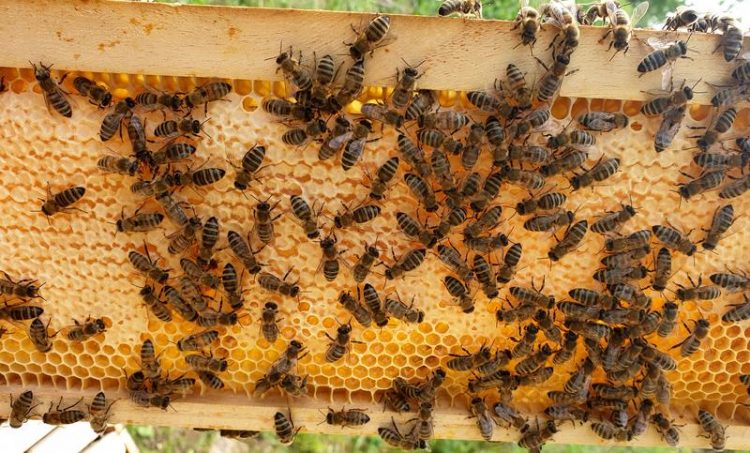When bees are freezing

Bees can fight parasites in their hive with different methods © MPI-P
A beehive is a complex ecosystem – not every bee can be considered separately, but the accumulation of all bees can be seen as a unique and huge superorganism that lives and works – but can also become ill.
The most important bee parasite worldwide is the so-called “Varroa mite”, which triggers the bee disease “Varrose”. Larvae are damaged, which makes the hatching bees about one tenth smaller than healthy bees.
“After about 18 months after the first infection, a hive is dead if nothing is done about it,” says Dr. Stanislav Balouchev of the MPI-P.
One of the bees' most important weapons in the fight against the disease is the increased temperature that bees can produce in their hives. Bees can press their chest against a honeycomb and by moving their chest muscles increase the temperature inside the honeycomb to such an extent that the mite multiplies much less and the colony dies within a short time.
In addition, infected bees can send out chemical warning signals, which ensure that other bees change their hygiene procedures and scratch the infected bee in order to shake off the mite.
Both methods – either by raising the temperature or by mechanically scraping off the mite – require sufficient energy, which the bees have to draw from the valuable supply of honey. “Where there are enough flowers and thus nectar, for example in South-East Asia, where the Varroa mite originally comes from, these Eastern bees (Apis cerana) do not need to save energy,” explains Stanislav Balouchev.
“In our region, however, nectar is a precious resource for the native western bees (Apis mellifera), and bees do not have an infinite amount of energy left to fight Varrose.”
In a recently launched project funded by the Volkswagen Foundation, the scientists of Prof. Katharina Landfester's department want to measure the temperature in a beehive. “We want to measure the optimum temperature distribution in three dimensions,” says Prof. Landfester.
“The average temperature, as obtained with thermometers, for example, is of no use to us in this case – we want to use the three-dimensional temperature distribution to determine whether a hive is still healthy or is already infected in individual combs.”
The researchers are therefore planning to develop miniature temperature sensors that have to meet certain requirements for use. On the one hand, they must have an accuracy that allows a temperature measurement better than 0.1 °C. On the other hand, the measuring device must be accepted by the bees: The sensors must literally not “smell”.
“We are planning to develop the sensors in such a way that we can print them ourselves with a 3D printer as required and thus measure the temperature in each individual honeycomb,” says Katharina Landfester. “If we detect deviations from the optimal temperature distribution, the next step will be to develop an active temperature control system that allows the temperature to be raised at specific points in the hive.”
Several hives have now been set up at the MPI-P for the project. Over the next few months, the bees will be able to adapt to their new environment before the scientists start developing sensors and equipping the hives with them.
Prof. Dr. Katharina Landfester
landfest@mpip-mainz.mpg.de
Tel.: 06131-379 170
Dr. Stanislav Balouchev
balouche@mpip-mainz.mpg.de
Tel.: 06131-379 485
Media Contact
More Information:
http://www.mpip-mainz.mpg.deAll latest news from the category: Life Sciences and Chemistry
Articles and reports from the Life Sciences and chemistry area deal with applied and basic research into modern biology, chemistry and human medicine.
Valuable information can be found on a range of life sciences fields including bacteriology, biochemistry, bionics, bioinformatics, biophysics, biotechnology, genetics, geobotany, human biology, marine biology, microbiology, molecular biology, cellular biology, zoology, bioinorganic chemistry, microchemistry and environmental chemistry.
Newest articles

A ‘language’ for ML models to predict nanopore properties
A large number of 2D materials like graphene can have nanopores – small holes formed by missing atoms through which foreign substances can pass. The properties of these nanopores dictate many…

Clinically validated, wearable ultrasound patch
… for continuous blood pressure monitoring. A team of researchers at the University of California San Diego has developed a new and improved wearable ultrasound patch for continuous and noninvasive…

A new puzzle piece for string theory research
Dr. Ksenia Fedosova from the Cluster of Excellence Mathematics Münster, along with an international research team, has proven a conjecture in string theory that physicists had proposed regarding certain equations….



